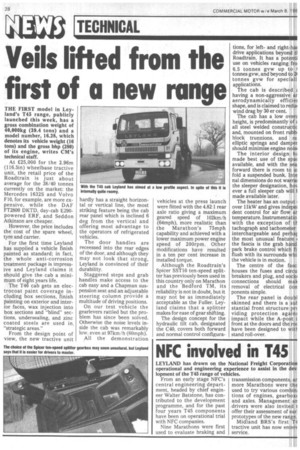Veils lifted from the first of a new range
Page 30

If you've noticed an error in this article please click here to report it so we can fix it.
THE FIRST model in Leyland's 145 range, publicly launched this week, has a gross combination weight of 40,000kg (39.4 tons) and a model number, 16.28, which denotes its vehicle weight (16 tons) and the gross bhp (280) of its engine, writes CM's technical staff.
At E25,000 for the 2.96m (116.5in) wheelbase tractive unit, the retail price of the Roadtrain is just about average for the 38/40 tonnes currently on the market: the Mercedes I632S and Volvo F10, for example, are more expensive, while the DAF FT2800 DKTD, day-cab E290powered ERF, and Seddon Atkinson are cheaper.
However, the price includes the cost of the spare wheel, tyre and carrier.
For the first time Leyland has supplied a vehicle finish painted as standard; in fact, the whole anti-corrosion treatment package is impressive and Leyland claims it should give the cab a minimum of eight years life.
The T46 cab gets an electrocoat paint coverage including box sections, finish painting on exterior and interior faces, wax injection into box sections and "blind" sections, undersealing, and zinc coated steels are used in, "strategic areas."
From the design point of view, the new tractive unit hardly has a straight horizontal or vertical line, the most striking feature being the cab rear panel which is inclined 6 deg from the vertical and offering most advantage to the operators of refrigerated vehicles.
The door handles are receessed into the rear edges of the door, and although they may not look that strong, Leyland is convinced of their durability.
Staggered steps and grab handles make access to the cab easy and a Chapman suspension seat and an adjustable steering column provide a multitude of driving positions.
On our test vehicle the gearlevers rattled but the problem has since been solved. Otherwise the noise levels inside the cab was remarkably low, even at 97km /h (60mph).
All the demonstration vehicles at the press launch were fitted with the 4.82:1 rear axle ratio giving a maximum geared speed of 102km/h (64mph), more realistic than the Marathon's 75mph capability and achieved with a lower maximum power engine speed of 200rpm. Other modifications have resulted in a ten per cent increase in installed torque.
Although the Roadtrain's Spicer SST10 ten-speed splitter has previously been used in this country only on Marathon and the Bedford TM, its reliability is not in doubt, but it may not be as immediately acceptable as the Fuller. Leyland claims that a splitter makes for ease of gear shifting.
The design concept for the hydraulic tilt cab, designated the C40, covers both forward and normal control configura tions, for leftand right-hal drive applications beyond tl Roadtrain. It has a potenti use on vehicles ranging fro 6.5 tonnes gvw up to tonnes gvw, and beyond to 21 tonnes gvw for speciali applications.
The cab is described i having a non-aggressive ar aerodynamically efficiei shape, and is claimed to redu4 wind drag by 30 er cent.
The cab has a low overE height, is predominantly of E all steel welded construed( and, mounted on front rubb, block trunnions, and re elliptic springs and damper should minimise engine nois( The interior design ha made best use of the spa( available, and with the sea forward there is room to ui fold a suspended bunk. Inte nal dimensions do not warrai the sleeper designation, hox ever a full sleeper cab will I made available later.
The heater has an output over 11kW and gives indepei dent control for air flow ar temperature. Instrumentatio with the exception of tt tachograph and tachometer interchargeable and perha/ the most unusual feature the fascia is the grab hand park brake control which ft flush with its surrounds whi the vehicle is in motion.
The centre of the fasc houses the fuses and circu breakers and plug, and sockg connections should mak removal of electrical con ponents simple.
The rear panel is doubl skinned and there is a sut stantial front structure prt viding protection again impact while the A-post i front at the doors and the roc have been designed to witl stand roll-over.












































































































































































